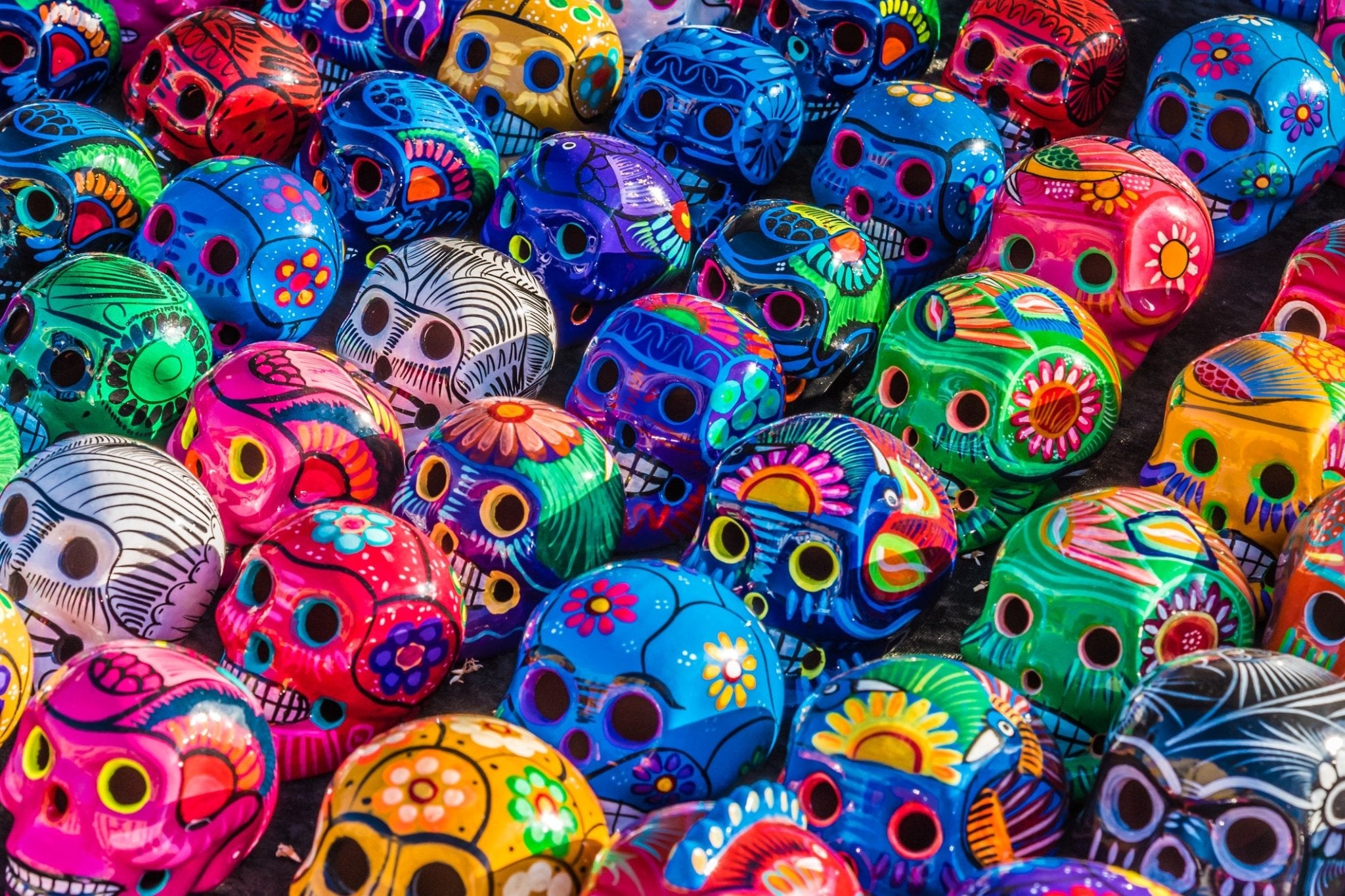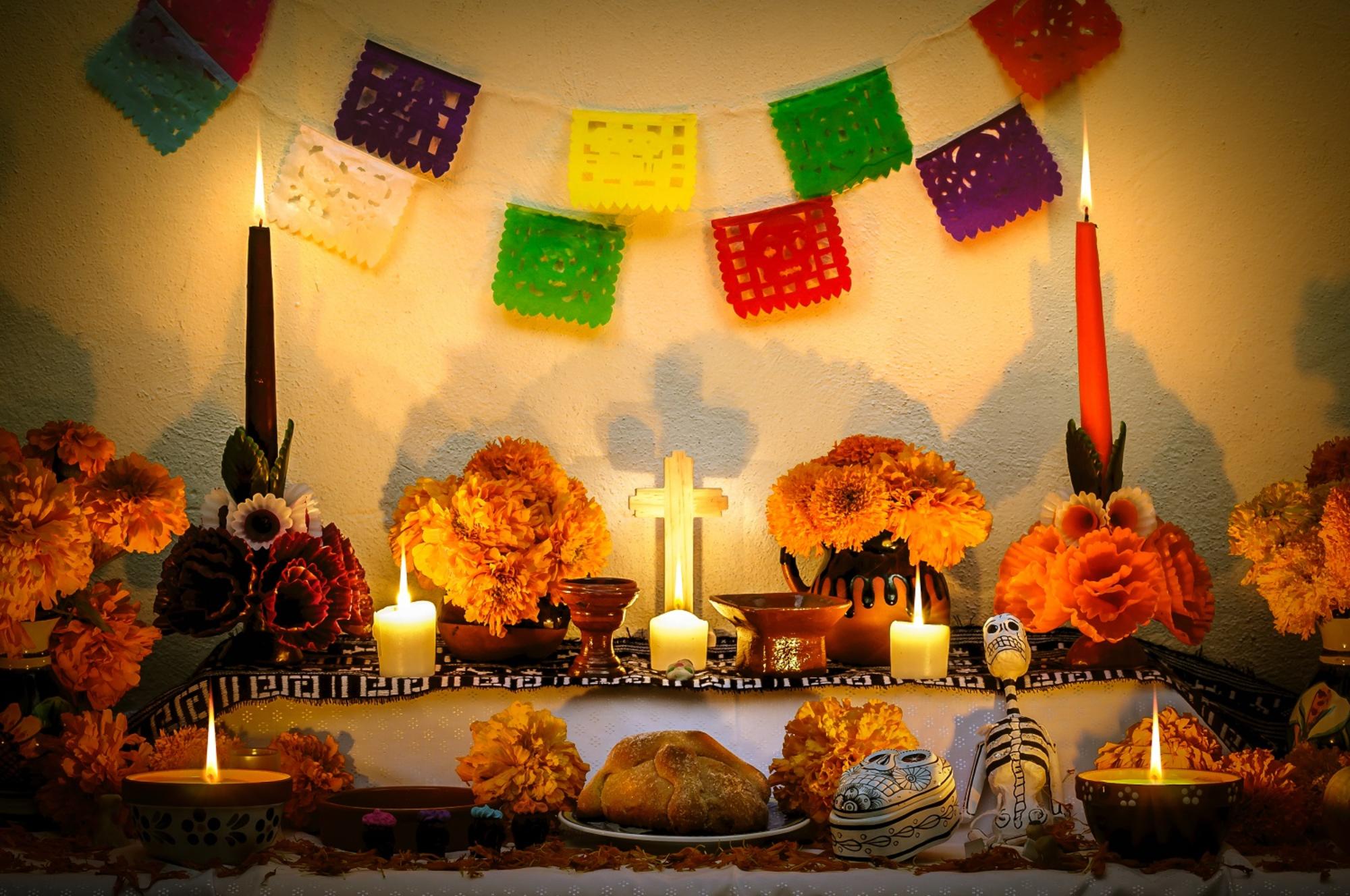
Learn More About Mexico's Day of the Dead
Tags:
Day of the Dead (or Día de Muertos) is one of Mexico’s most iconic holidays, and it is now known throughout the world. Named as Intangible Cultural Heritage by the UNESCO in 2008, Día de Muertos is when we remember and honor our deceased loved ones with the hope that they will travel back from the underworld to visit us for the night.
 This holiday is syncretism in its whole expression. Today’s Day of the Dead rituals are the combination of beliefs and traditions that have merged into now what is one of Mexico’s most diverse holidays. Its origins date back to pre-hispanic times - the central and southern regions of the Mexican territory once known as Mesoamerica where inhabited by many different indigenous groups, and this months-long celebration was integral to their yearly religious rituals.
The 3,000-year old celebration was originally held during the summer months of July and August, with a single month for honoring deceased children, and one for adults. Rites and rituals were dedicated to the goddess of the underworld Mictecacihuatl (an echo of which you can see in today’s Catrina skeletons). It was common for indigenous practitioners to keep the skulls of the dead and include them as part of their altars.
The Spanish colonizers were offended with many of the pagan traditions of Mexico’s original inhabitants. The Catholic Church, which as you know played an outsized role in the colonization of Mexico, would eventually enforce a change to the dates of the celebration so that it coincided with the Catholic festival of All Saints Day at the end of October. More than simply a day of remembrance, Day of the Dead is an invitation for those that have gone before to come back for a night and visit the living they left behind.
Nowadays, people still welcome their relatives by visiting their gravesites and bringing along goodies such as food, candles and even mariachi bands! They simply go to be with them. Others set up altars in their houses and wait for the spirits to visit.
This holiday is syncretism in its whole expression. Today’s Day of the Dead rituals are the combination of beliefs and traditions that have merged into now what is one of Mexico’s most diverse holidays. Its origins date back to pre-hispanic times - the central and southern regions of the Mexican territory once known as Mesoamerica where inhabited by many different indigenous groups, and this months-long celebration was integral to their yearly religious rituals.
The 3,000-year old celebration was originally held during the summer months of July and August, with a single month for honoring deceased children, and one for adults. Rites and rituals were dedicated to the goddess of the underworld Mictecacihuatl (an echo of which you can see in today’s Catrina skeletons). It was common for indigenous practitioners to keep the skulls of the dead and include them as part of their altars.
The Spanish colonizers were offended with many of the pagan traditions of Mexico’s original inhabitants. The Catholic Church, which as you know played an outsized role in the colonization of Mexico, would eventually enforce a change to the dates of the celebration so that it coincided with the Catholic festival of All Saints Day at the end of October. More than simply a day of remembrance, Day of the Dead is an invitation for those that have gone before to come back for a night and visit the living they left behind.
Nowadays, people still welcome their relatives by visiting their gravesites and bringing along goodies such as food, candles and even mariachi bands! They simply go to be with them. Others set up altars in their houses and wait for the spirits to visit.
 The altar, also known as an ofrenda, consists of a table filled with food and various other offerings to the souls of the departed. They can vary from state to state but always consist of the following basics:
The altar, also known as an ofrenda, consists of a table filled with food and various other offerings to the souls of the departed. They can vary from state to state but always consist of the following basics:
 Starting in the middle of October, bakeries start to make a very special pastry just for this celebration. Its presentation varies a lot, but in the central parts of Mexico it’s a round bun made with orange blossom-perfumed dough and topped with a crust of dough stripes and dough balls to represent a cadaver’s skull and limbs. The bun is dusted with white sugar or smeared with butter and sugar.
Starting in the middle of October, bakeries start to make a very special pastry just for this celebration. Its presentation varies a lot, but in the central parts of Mexico it’s a round bun made with orange blossom-perfumed dough and topped with a crust of dough stripes and dough balls to represent a cadaver’s skull and limbs. The bun is dusted with white sugar or smeared with butter and sugar.

 This holiday is syncretism in its whole expression. Today’s Day of the Dead rituals are the combination of beliefs and traditions that have merged into now what is one of Mexico’s most diverse holidays. Its origins date back to pre-hispanic times - the central and southern regions of the Mexican territory once known as Mesoamerica where inhabited by many different indigenous groups, and this months-long celebration was integral to their yearly religious rituals.
The 3,000-year old celebration was originally held during the summer months of July and August, with a single month for honoring deceased children, and one for adults. Rites and rituals were dedicated to the goddess of the underworld Mictecacihuatl (an echo of which you can see in today’s Catrina skeletons). It was common for indigenous practitioners to keep the skulls of the dead and include them as part of their altars.
The Spanish colonizers were offended with many of the pagan traditions of Mexico’s original inhabitants. The Catholic Church, which as you know played an outsized role in the colonization of Mexico, would eventually enforce a change to the dates of the celebration so that it coincided with the Catholic festival of All Saints Day at the end of October. More than simply a day of remembrance, Day of the Dead is an invitation for those that have gone before to come back for a night and visit the living they left behind.
Nowadays, people still welcome their relatives by visiting their gravesites and bringing along goodies such as food, candles and even mariachi bands! They simply go to be with them. Others set up altars in their houses and wait for the spirits to visit.
This holiday is syncretism in its whole expression. Today’s Day of the Dead rituals are the combination of beliefs and traditions that have merged into now what is one of Mexico’s most diverse holidays. Its origins date back to pre-hispanic times - the central and southern regions of the Mexican territory once known as Mesoamerica where inhabited by many different indigenous groups, and this months-long celebration was integral to their yearly religious rituals.
The 3,000-year old celebration was originally held during the summer months of July and August, with a single month for honoring deceased children, and one for adults. Rites and rituals were dedicated to the goddess of the underworld Mictecacihuatl (an echo of which you can see in today’s Catrina skeletons). It was common for indigenous practitioners to keep the skulls of the dead and include them as part of their altars.
The Spanish colonizers were offended with many of the pagan traditions of Mexico’s original inhabitants. The Catholic Church, which as you know played an outsized role in the colonization of Mexico, would eventually enforce a change to the dates of the celebration so that it coincided with the Catholic festival of All Saints Day at the end of October. More than simply a day of remembrance, Day of the Dead is an invitation for those that have gone before to come back for a night and visit the living they left behind.
Nowadays, people still welcome their relatives by visiting their gravesites and bringing along goodies such as food, candles and even mariachi bands! They simply go to be with them. Others set up altars in their houses and wait for the spirits to visit.
 The altar, also known as an ofrenda, consists of a table filled with food and various other offerings to the souls of the departed. They can vary from state to state but always consist of the following basics:
The altar, also known as an ofrenda, consists of a table filled with food and various other offerings to the souls of the departed. They can vary from state to state but always consist of the following basics:
A picture of the departed.
In order for the spirits to recognize who the altar is dedicated to, a picture of the person to be remembered is set in the middle of the table.Day of the Dead bread.
 Starting in the middle of October, bakeries start to make a very special pastry just for this celebration. Its presentation varies a lot, but in the central parts of Mexico it’s a round bun made with orange blossom-perfumed dough and topped with a crust of dough stripes and dough balls to represent a cadaver’s skull and limbs. The bun is dusted with white sugar or smeared with butter and sugar.
Starting in the middle of October, bakeries start to make a very special pastry just for this celebration. Its presentation varies a lot, but in the central parts of Mexico it’s a round bun made with orange blossom-perfumed dough and topped with a crust of dough stripes and dough balls to represent a cadaver’s skull and limbs. The bun is dusted with white sugar or smeared with butter and sugar.
Flowers, candles and incense.
A flower, similar to marigold, called Cempazúchitl or the Aztec marigold, is used throughout the country during this festivity. Their smell and yellow petals are thought to guide souls home along with the light of candles and the scent of incense.Favorite foods and objects of the deceased.
Dishes and foods the deceased enjoyed in life, such as enchiladas, mole or rice, are provided for them to feast on during their visit. According to legend, after the night has passed, the dishes have lost their “essence” and are therefore inedible for anyone else and have to be thrown out. Objects like books and toys are also offered for the enjoyment of the returning spirit.Water, salt and a spirit.
Since the souls make a very long and tiresome journey, they are offered water or even a spirit to quench their thirst and make their stay more enjoyable. A plate of pure salt is set out to purify the spirit.
Sugar skulls and papel picado.
A splash of color is added to the altar with sugar skulls and papel picado - tissue paper flags with intricate designs cut into them. Although nowadays the skulls can be made out of amaranth or chocolate, the traditional ones are made of white sugar, decorated with tinted frosting, and have a name written on their forehead. The tissue paper flags come in many different colors and the carved out images of skeletons are present in every altar.Would you like to be the first to hear about our new products and more? Sign up for our Nature’s Path Newsletter.

